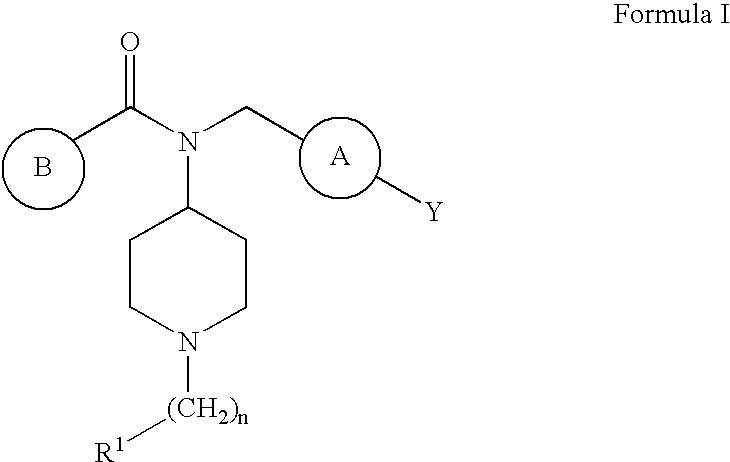Novel 4-Aminopiperidine Derivatives
a technology of aminoopiperidine and derivatives, applied in the field of new aminoopiperidine derivatives, can solve the problems of increasing the risk of developing a new strain of i>p. falciparum /i>, increasing the risk of developing a new strain of i>p. falciparum, and increasing the need for new drugs
- Summary
- Abstract
- Description
- Claims
- Application Information
AI Technical Summary
Benefits of technology
Problems solved by technology
Method used
Image
Examples
example 2
[0155]
[0156] 4-(4-Nitro-benzylamino)-piperidine-1-carboxylic acid tert-butyl ester (3): A solution of 4-amino-N-Boc-piperidine hydrochloride (1) (5.0 g, 21.12 mmol), 4-nitrobenzaldehyde (2) (3.19 g, 21.12 mmol) and triethylamine (2.9 ml, 21.12 mmol) was refluxed in methanol (100 ml) for 21 h followed by the addition of sodium borohydride (1.28 g, 33.79 mmol) at rt. Stirring was continued for 6 h. Saturated sodium bicarbonate solution was added to the reaction mixture and the product was extracted with ethyl acetate (3×100 ml). The combined organic layers were washed with brine, dried over magnesium sulfate, filtered and concentrated under reduced pressure to give 7.2 g (98%) of 3 as an orange oil.
[0157] 4-[(4-Nitro-benzyl)-(4-pentyl-benzoyl)-amino]-piperidine-1-carboxylic acid tert-butyl ester (5): Compound 3 (7.65 g, 22.81 mmol) was dissolved in dichloromethane (530 ml) followed by the addition of Hünigs base (DIPEA, 8.84 g, 68.43 mmol) and the slow addition of 4-pentylbenzoyl chl...
example 127
[0163]
[0164] Compound 18 was prepared according to procedures described in the synthetic protocols for the preparation of example 2.
[0165] N-[4-(N-Hydroxycarbamimidoyl)-benzyl]-N-[1-(3-methyl-butyl)-piperidin-4-yl]-4-pentyl-benzamide (20): Compound 18 (9 g, 19.58 mmol) was dissolved in ethanol (40 ml) followed by the addition of hydroxylamine hydrochloride (1.5 g, 21.6 mmol) and sodium hydrogencarbonate (1.81 g, 21.6 mmol). The reaction mixture was heated to reflux for 1 h. The ethanol was removed under reduced pressure. The residue was taken up into water (100 ml) and extracted with ethyl acetate (3×60 ml). The combined organic layers were dried over magnesium sulfate, filtered and evaporated to give the product 20 (5.8 g, 60%), which was used in the subsequent parallel chemistry step without further purification.
[0166] N-[1-(3-Methyl-butyl)-piperidin-4-yl]-4-pentyl-N-[4-(5-phenyl-[1,2,4]oxadiazol-3-yl)-benzyl]-benzamide (22): Benzoic acid (21, 24.4 mg, 0.2 mmol) was dissolved in...
example 144
[0167]
[0168] Compound 27 (4-{[[1-(3-methyl-butyl)-piperidin-4-yl]-(4-pentyl-benzoyl)-amino]-methyl}-benzoic acid methyl ester) was prepared according to procedures described above and served as the starting material for compound 29 and analoguous derivatives in a parallel chemistry setting.
[0169] N-[1-(3-Methyl-butyl)-piperidin-4-yl]-N-[4-(3-methyl-isoxazol-5-yl)-benzyl]-4-pentyl-benzamide (29): Acetone oxime (28, 44 mg, 0.6 mmol)) was dissolved in THF (1.2 ml) and cooled to 0° C. BuLi (0.83 ml of 1.6M solution in hexane) was added and the reaction mixture was allowed to warm to rt for 1 h followed by the addition of a solution of compound 27 (98.5 mg, 0.2 mmol) in THF (2 ml) at 0° C. The reaction mixture was stirred at rt for 14 h followed by slow addition of conc. sulfuric acid (0.08 ml) and stirring was continued for 15 min. The mixture was then poured onto sat. sodium carbonate solution (4 ml) and the product extracted with ethyl acetate (3×4 ml). The combined organic layers we...
PUM
| Property | Measurement | Unit |
|---|---|---|
| weight | aaaaa | aaaaa |
| weight | aaaaa | aaaaa |
| weight | aaaaa | aaaaa |
Abstract
Description
Claims
Application Information
 Login to View More
Login to View More - R&D
- Intellectual Property
- Life Sciences
- Materials
- Tech Scout
- Unparalleled Data Quality
- Higher Quality Content
- 60% Fewer Hallucinations
Browse by: Latest US Patents, China's latest patents, Technical Efficacy Thesaurus, Application Domain, Technology Topic, Popular Technical Reports.
© 2025 PatSnap. All rights reserved.Legal|Privacy policy|Modern Slavery Act Transparency Statement|Sitemap|About US| Contact US: help@patsnap.com



